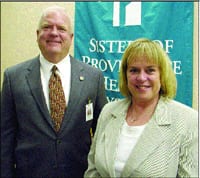Catch the Spirit SPHS Campaign Designed To Raise Awareness, Support
They’re calling it a ‘friend-raising’ effort. That’s the term organizers are using to describe the Catch the Spirit campaign being conducted by the Sisters of Providence Health System (SPHS). Now in its second year, the program, orchestrated by the system’s fund development department, isn’t raising money — at least not at this stage.
Instead, the initial goal is to raise awareness, said Brenda McCormick, MSW, LICSW, who is vice president of fund development for the system, although she prefers the word philanthropy to describe what she does. McCormick told The Healthcare News that the Catch the Spirit campaign was launched to educate the public about the SPHS and thereby also generate support — which can come in a number of ways, from people signing on as volunteers, and perhaps even trustees, to monetary donations down the line.
“At this stage, we’re building relationships,” she explained, adding that the Spirit program included one large gathering last fall, called ‘Continue the Legacy,’ that was attended by more than 300 people. But the campaign features mostly small (15-20 people) and intimate gatherings designed to inform and inspire attendees — some of whom are already familiar with the system, its history, and its current and future challenges, but many are not — while creating what organizers call a ‘dialogue.’
“We want to build life-long friends,” said McCormick, noting that the Sisters of Providence who founded and, in many cases, administered the health care facilities in the system, are passing on, and thus the SPHS wants to tell their story now, while also recruiting individuals to carry on their work.
Vincent J. McCorkle, president and CEO of the SPHS, said the Catch the Spirit initiative, part of a five-year strategic plan for philanthropy, was launched primarily as an awareness campaign. It is needed, he said, because there are many things that the public may not know and should know, starting with the Sisters of Providence and their mission.
Many in the community are not aware, for example, that some of the better-known health care facilities in the region, including Mercy Hospital, Brightside, the Providence Behavioral Health Hospital, formerly Providence Hospital, are all part of the broader SPHS system, he explained. Also unknown to many is the fact that many of the programs provided in those facilities — such as behavioral health services and care for the elderly — are essentially losing propositions, from a financial standpoint, and have been discontinued by other health care systems for that reason.
“We’re more than just a business, we’re a ministry,” McCorkle told attendees of the May 24 forum. “This is a system that makes decisions not just on sound business models, but against a defined set of values.”
McCorkle told The Healthcare News that, while the Catch the Spirit campaign was created to allow the system to “tell its story,” it has done more than merely inform forum attendees. It has also helped inspire employees, who hear and tell stories about how the sisters’ mission manifests itself today.
“It’s like a shot of adrenaline,” he said of the sessions and the human interest stories relayed during them. “It reminds me of why I got into health care to begin with.”
The Healthcare News looks this month at the Catch the Spirit initiative and its many different goals.
Mission: In Progress
This year’s Catch the Spirit sessions start with an informational video (created earlier this spring) about the system and the sisters who created it. At one point, the narrator states that there are a mere 80 sisters still living.
As he addressed the May 24 gathering, McCorkle updated that figure to 77, and said it falls at the rate of one per month.
The passing on of the sisters, who once were the backbone of the health care system they created, and the desire to tell their story is one of the primary motivations behind the Spirit campaign, said McCormick. But there are many goals behind this strategic initiative she created for the system to take philanthropy into the future and to a higher plane.
“I was here only a short time when I realized that relationship-building wasn’t something that we put much focus on,” she said. “In order to have people understand who you are and what you stand for — and to someday have them give support — you have to build relationships with these individuals. That’s what this campaign is all about.”
The Catch the Spirit program is modeled, in many respects, after a fund-development strategy championed by Terry Axelrod, a noted expert and author on the subject of philanthropy — her latest title is called, simply, Raising More Money. At the heart of that strategy, said McCormick, is the premise that before individuals will back a cause or organization, they must know about it and become inspired to support it.
The Axelrod model has been used primarily with single entities, she explained, adding that the SPHS is different in that it has a number of interconnected facilities in several area communities. “We’re more complicated; we have a lot of moving parts,” said McCormick. “Time and again, people would tell me they didn’t know these various facilities were part of our system — or that there was a system.”
To explain all those moving parts, campaign organizers scheduled a series of sessions that would be attended by elected officials, business and civic leaders, and others involved in the community. The inivitation would be shaped by referrals from forum attendees. The individual events — there have been 16 to date, with 12 in 2004 — were designed to be informational, while driving home the point about the compassionate nature of individual programs and the people working within them.
In the campaign’s first year, the dozen conducted sessions featured detailed looks at Brightside for Families and Children in West Springfield and the Sr. Mary Caritas Cancer Treatment Center at the Mercy Medical Center campus in Springfield. This year, the sessions have focused on behavioral health care and services provided to the elderly.
One of the speakers at the May 24 session was Anne Nusbaum, nurse manager at the Farren Care Center, or ‘The Farren’ as it’s called. This is a facility she described as the only one of its kind, a last resort for people (usually abandoned by their families) with psychiatric or medical conditions that essentially make them dangerous. To be considered for admission, individuals must first have been rejected by five different nursing homes due to their behavioral patterns.
“Society has essentially rejected these people; this is the end of the line for them,” said Nusbaum. “We take them because no one else will accept them.”
But the facility does not warehouse these individuals; instead it works to improve their quality of life by helping them interact with others, she explained.
Other speakers included Lisa Golembiewski, manager of outpatient services with Providence Behavioral Health Hospital, who told attendees about the growing problem of substance abuse in the region, and also about the facility’s adolescent behavioral health services, the only program in the state west of Rte. 128.
Also taking the podium was George Kennedy, director of admissions at St. Luke’s Home in Springfield. As he talked about the facility, which has had a number of functions in its 150-year history, including stints as a birthing center and later a residence for the elderly, Kennedy displayed a painting of the home. A magnified image of the work revealed several Sisters of Providence taking a break, as he put it, on the home’s roof.
Those invited to the informational sessions are asked for input on what they’ve seen and heard, said McCormick, and also for the names of other area individuals to be invited to future programs. When the first phase of the campaign, the informational component, is completed, the system will move on to what she termed a “call to action.”
This will come in the form of invitations to participate on a number of levels, she said, noting that the system will need everything from volunteers to serve within the system’s various facilities to trustees for the boards that administer them.
“There are endless roles for individuals who would like to spend some time with us in a volunteer capacity,” she said, adding that, as more people become aware of the system’s programs and then become involved with them, philanthropic giving is a natural next step.
When asked how the system will measure the success of the program. McCormick said there will be several different yardsticks, starting with the number of individuals who agree to take an active role in continuing the legacy of the Sisters of Providence. Monetary support will obviously be another measure, she said, adding that the ultimate indicator will be the number of lasting relationships that are created — something that won’t be known for some time.
McCorkle agreed, but said that, in his mind, the campaign has already been successful, because of its dialogue-generating capabilities and the energy it is creating both within the system and outside it.
“This has re-energized me and many other people here,” he said. “When you see the way people react to the stories being told, and when you see the pride displayed by our staff, you know that this is having a very positive impact.”
When the Spirit Moves You
As she talked about the Catch the Spirit program and the individual informational sessions, McCormick compared them to inviting a guest to your home for the first time.
“That’s how relationships get started and how friends are made — you start with introductions and getting to know each other,” she explained.
The SPHS wants to build some life-long friendships, and is starting by building awareness of the system, its mission, and its many challenges moving forward.
Only time will tell if the campaign and its various components are successful, but McCormick believes that by first focusing on friend-raising, the system will succeed in prompting many within the community to catch the spirit.



Comments are closed.